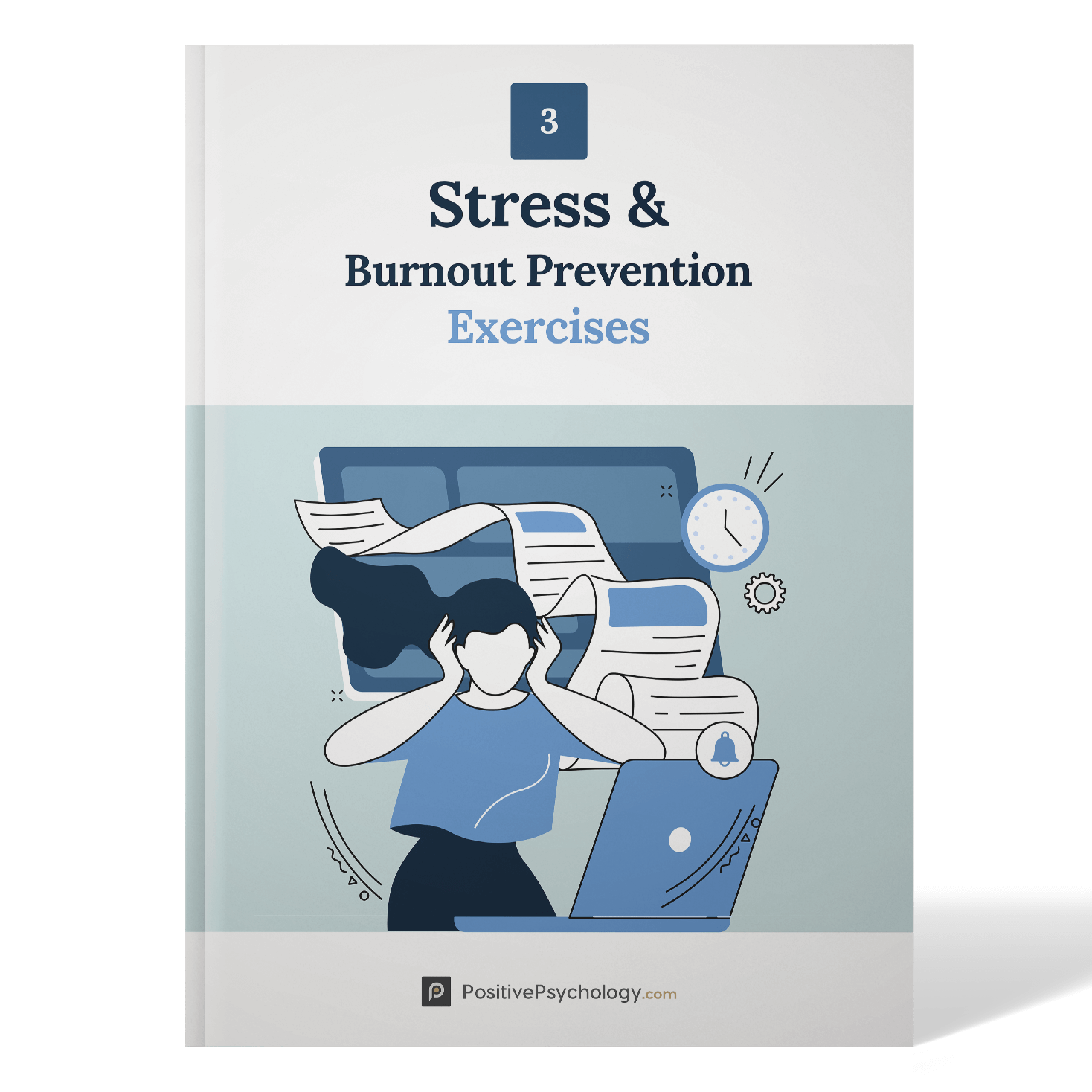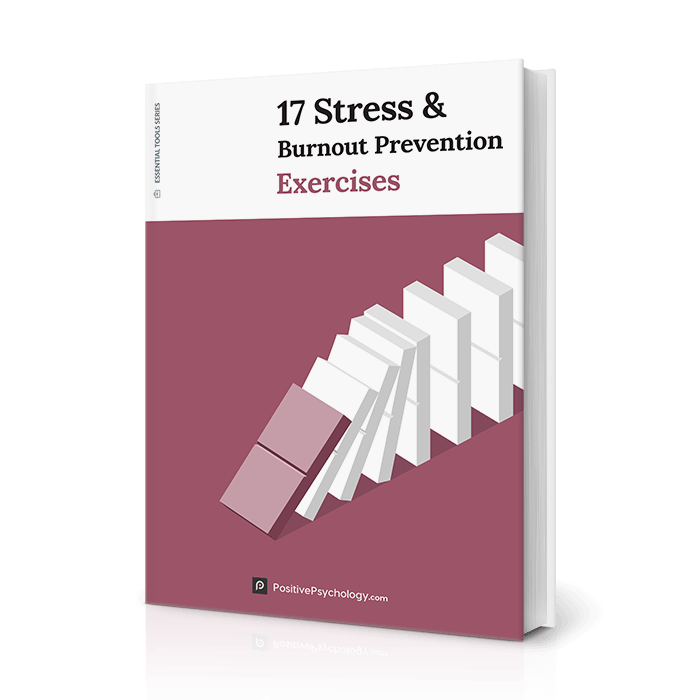

Anxiety can be brutal, limiting where we go, what we do, and who we meet.
And yet, it can also be energizing, focusing our attention and preparing us for action — an evolutionary response to the unexpected, difficult, or downright dangerous (Workman & Reader, 2015).
It is not so much what happens but how we respond that matters the most (Joseph, 2013).
Therapists, counselors, and coaches can help by working with clients to change how they react to anxiety-inducing situations.
In this article, we introduce a collection of free worksheets for use by mental health professionals with their clients or as self-help activities.
Before you continue, we thought you might like to download our three Stress & Burnout Prevention Exercises (PDF) for free. These science-based exercises will equip you and your clients with tools to better manage stress and find a healthier balance in your life.
We can learn to break free from anxiety. With the right approaches, the same situations can have different outcomes (Forsyth & Eifert, 2016).
The following five worksheets encourage clients to recognize that they are not alone in their experiences and can, indeed, learn how to cope with anxiety.
The activities work on their own or can be combined. They support clients by helping them identify situations that cause anxiety, using mindfulness and meditation to restore a balanced perspective, and recognizing that someone should not be defined by the extreme emotions they are experiencing (Forsyth & Eifert, 2016; Southwick & Charney, 2018):
Intense fears, phobias, and stressful situations can be highly anxiety provoking. It is helpful to establish a list of challenging situations that result in extreme upset or negative emotions for clients (American Psychological Association, 2016).
Use the Anxiety Hierarchy exercise to list situations that lead to anxiety and rate them on a scale from 1 (mild discomfort) to 10 (extreme emotions such as panic).
Once these anxiety-inducing situations are listed and sorted in order, the practitioner can use graded exposure practices as part of systematic desensitization.
Waiting for an event can leave us excited, concerned, nervous, or anxious. We may notice changes to our physiology (increased heart rate, sweating, and faster breathing), cognition (erratic thinking, poor decision-making, and a failing memory), and emotions (fear, upset, and panic; Peterson, 2018).
Work with the client to identify times they are waiting during the week — for example, waiting for the bus, at the school gates, at an appointment — and how they expect to feel.
Then use this breath awareness practice for mindful breathing: slowly breathing in through the nose, holding, and slowly breathing out through the mouth. As unhelpful thoughts enter the mind, direct attention back to breathing.
Our behavior often follows patterns, and so does our anxiety. It is possible to anticipate when anxiety might show up, especially when we become more in tune with our bodies and the events around us (Peterson, 2018).
By creating a mindfulness anxiety plan, we can be ready with a list of actions to perform when we begin to recognize our anxiety taking shape and in advance of situations that can be difficult. These actions should aim to improve our wellbeing and leave us less anxious throughout the day
For example, “If my anxiety is getting away from me, I will call my best friend.” Or “Every day, I will go outside for a walk at lunchtime and try to be more mindful.”
We are not our emotions, but when fearful or anxious, we spend a great deal of time and energy focusing on what is wrong with us, forgetting our strengths (Forsyth & Eifert, 2016).
In this exercise, the client mindful reflects on the following prompts (among others):
I am someone who …
I really like …
My most important relationship is …
I feel my best when …
Reading through the answers helps remind us that anxiety does not define who we are.
Often, we stop ourselves from taking on or embracing a challenge for fear of failure or experiencing anxiety.
Despite its foreboding name, the Funeral Meditation is used within Acceptance and Commitment Therapy to help free ourselves from the grip of anxiety (Forsyth & Eifert, 2016).
This powerful meditation helps us reflect on what matters to us, recognizing that, at any time, we can start living in line with how we want to be remembered.
After several calming breaths, we imagine what our funeral would be like, including:
How do people look?
Who would be there?
What would they say?
What would we like people to say about us?
Recognizing our values can help us eliminate anxiety and begin living the way we want.
Anxiety can be devastating for our youth population, impacting their academic achievement and conduct in school and increasing the likelihood of obesity, personality disorders, substance abuse, and poor social relationships (Khesht-Masjedi et al., 2019).
The following worksheets can also be adapted for adult populations, and mental health practitioners will find them valuable when working with adolescents coping with anxiety.
Children and teens can benefit from stepping back from anxiety-inducing situations to reflect upon how, despite being scary, they can also be exciting.
For example, joining a new class, school, or social group can bring with it feelings of anxiety. When also recognized as exciting, it can be energizing, leading to positive emotions such as hope, curiosity, and gratitude.
Work with your teen client to:
Identifying how something fills us with fear while providing energy can help us have a more balanced view regarding how to approach what is ahead.
This helpful worksheet helps teach acceptance of difficult feelings (rather than hiding from or rejecting them) through self-acceptance and self-compassion (Khazan, 2019).
The FLARE acronym directs the client to:
By focusing on positive emotions, the approach builds toward a spiral of positive feelings (Fredrickson, 2010).
Teenagers are vulnerable to focusing on the worst events, situations, and outcomes. As a result, it can almost seem like an endless radio program playing in the background, broadcasting negative stories and songs all day long.
While it’s not easy to turn down the volume on the radio (or turn it off completely), we can attend to it less. By learning to treat such negative thinking as background noise and focusing more on current activities, its impact and ability to heighten anxiety are reduced.
Children and adolescents (and even adults) feel scared sometimes. And that’s OK. It’s a perfectly normal fight-or-flight response to a perceived — or actual — uncomfortable or dangerous situation.
Talking to an adult can help.
When I’m Scared can be used with individual youths or in a group setting.
They are asked to write down what makes them frightened, how it affects their thinking, how it feels physically, and one thing might be that makes them feel better.

These detailed, science-based exercises will equip you or your clients with tools to manage stress better and find a healthier balance in their life.
Download PDF
By filling out your name and email address below.
Social anxiety leads to persistent fear and the avoidance of social situations because of concerns about being evaluated by others (Schneier & Goldmark, 2015).
Therapy and the use of interventions enable clients to increase their social engagement and form deep, meaningful relationships (Schneier & Goldmark, 2015).
The following worksheets are valuable for mental health professionals helping clients identify what triggers their anxious thinking and manage them through visualization and mindfulness.
Our worries can mount up. Stresses, concerns, upsets, and things going wrong may seem never-ending, with even the most minor problems blown out of proportion, leaving our anxiety out of control.
This exercise captures situations that bother us and is particularly helpful for social anxiety, where we can begin to identify and reflect on unhelpful thought patterns and learn to expect and plan for how to handle them.
Visualization can feel as real to the mind as experiencing a situation first-hand — especially a social one — and offers a safe and controlled environment to explore and experiment with existing and future challenges (Clough & Strycharczyk, 2015).
Visualizing an event, especially one we are worrying about, can be a powerful and helpful way of reducing concern and anxiety and gaining confidence without the risk of failure or being overwhelmed.
Clients can repeat the visualization exercise several times until they feel comfortable and less anxious.
Anxiety can arise from any environment and is particularly common in social situations (Schneier & Goldmark, 2015).
Mindfulness can help us think about ourselves and our situations with more compassion and forgiveness and less judgment (Forsyth & Eifert, 2016).
In this exercise, the client imagines their life playing out as a movie on a screen. They capture on paper, nonjudgmentally, situations that leave them feeling anxious.
Following a series of grounding breaths, the client considers each one mindfully without becoming too involved.
Finally, they reflect on how reading the story now makes them feel. What is their degree of anxiety?

The Positive Psychology Toolkit© is a groundbreaking practitioner resource containing over 500 science-based exercises, activities, interventions, questionnaires, and assessments created by experts using the latest positive psychology research.
Updated monthly. 100% Science-based.
“The best positive psychology resource out there!”
— Emiliya Zhivotovskaya, Flourishing Center CEO
Anxiety can feel like it’s controlling us.
Changing your relationship with it can help us take charge of our lives (Forsyth & Eifert, 2016).
Try the following three activities to create coping strategies, identify what we can control while learning to accept everything else, and become more comfortable with discomfort.

Preparation is a crucial part of managing anxiety. This sheet contains a list of cards to help clients develop strategies for events and situations where they feel out of control and stressed, with their anxiety building.
Each card offers a valuable reminder of a powerful technique that will help them restore their physical, cognitive, emotional, and behavioral balance.
When I feel anxious, I could try … controlled breathing.
When I feel anxious, I could try … visualization.
When I feel anxious, I could try … a grounding technique.
Use them with psychoeducation and technique training to build confidence in the client’s ability to handle and overcome tough times.
We can’t control every situation, so it’s helpful to recognize those that can be influenced by our behavior and those that cannot.
The Control–Influence–Accept Model can stop individuals from feeling overwhelmed and experiencing feelings of hopelessness, frustration, and anxiety when they experience a loss of control or indecision (Thompson & Thompson, 2018).
The client is encouraged to perform each of the following:
Having performed each step, the client reflects on how they now feel about the situation and whether they are left wishing to control or influence anything they have accepted.
Anxiety has a strong physical element that we can use to increase awareness of panic-related physiological symptoms.
Interoceptive exposure is built on the premise that exposure to such sensations can increase our familiarity with them and our preparedness for future anxiety-inducing situations.
The worksheet uses activities that induce physical, cognitive, and emotional discomfort to replicate the sensations of panic and anxiety.
Note: These should only be used under the guidance of a physician or health professional in a suitably safe environment.
CBT self help for anxiety - GetselfhelpCognitive-Behavioral Therapy (CBT) treats anxiety by restructuring the client’s thinking, with the therapist exploring maladaptive expectations and worries related to upcoming events (Dobson & Dozois, 2021).
Reflecting on and sharing what makes us anxious can leave us feeling vulnerable, but it is essential. Understanding what leaves us feeling this way allows us to prepare for situations and learn appropriate coping skills.
One of the most powerful techniques is recognizing and, if possible, replacing unhelpful thinking.
Use the simple form in the worksheet to capture the following:
What does the anxiety feel like?
When does it happen?
What thoughts do you experience?
How realistic are these thoughts?
What thoughts could you replace them with?
Are they more realistic?
Capturing our anxieties is an essential part of reducing them and bringing them under control.
The two words “what if?” can be anxiety- inducing, sending our thoughts racing down a rabbit hole of all that could go wrong.
What if I forget the words when I’m on stage? What if my date doesn’t like me?
Reframing an experience helps us experience it differently. We can turn a negative into a positive — reverse the rabbit hole.
In this exercise, we write negative outcomes in the left-hand column and then a corresponding reversed, positive outcome on the right.
What if I nail the speech? What if my date goes really well?
Anxiety can bias our thinking by making us buy into the likelihood of something terrible happening. As a result, it can be helpful to consider the following three points:
What is the worst potential consequence of this scenario?
What is the best possible consequence of this scenario?
What do you feel is the most likely consequence of this scenario?
Following these questions, the client thinks about how it would feel in a year’s time if the worst actually happened.
After all, even if the worst outcome becomes a reality, it may be less catastrophic than we imagine.

Help your clients prevent burnout, handle stressors, and achieve a healthy, sustainable work-life balance with these 17 Stress & Burnout Prevention Exercises [PDF].
Created by Experts. 100% Science-based.
We have many resources available for therapists to support clients experiencing anxiety.
More extensive versions of the following tools are available with a subscription to the Positive Psychology Toolkit©, but they are described briefly below:
This exercise invites clients to examine the “helpfulness” of a thought they are having about a current challenging situation before formulating a more helpful alternative thought:
This exercise is valuable for stress reduction by connecting the sensations of relaxation with peaceful visual imagery during times of stress.
If you’re looking for more science-based ways to help others manage stress without spending hours on research and session prep, check out this collection of 17 validated stress management tools for practitioners. Use them to help others identify signs of burnout and create more balance in their lives.
Anxiety is a normal reaction to life events and can be beneficial in many situations, alerting us to dangers and increasing our attention and readiness for action.
It is often less about our environment or the challenges we face, but how we interpret them.
As a result, anxiety can dramatically impair our ability to function and perform in education, work, and social environments (American Psychological Association, 2016).
Its effects are widespread, impacting 30% of adults at some point in their lives and preventing them from living normally (American Psychiatric Association, 2021). They can find themselves avoiding opportunities and shying away from challenges due to intrusive thoughts or concerns.
Anxiety disorders are treatable. Therapists and counselors can help clients manage anxiety-inducing situations by changing how they view them and learning to cope with stressful conditions.
The anxiety worksheets in this article can be used independently or together as interventions for better managing anxiety. When combined with ongoing therapeutic assessment, it is possible to see how clients bring their feelings under control and return to the lives they wish to lead.
Ed: Updated March 2023
ReferencesJeremy Sutton, Ph.D., is an experienced psychologist, consultant, and coach. Jeremy also teaches psychology online at the University of Liverpool and works as a coach and educator, specialising in positive psychology, performance psychology, sports psychology, and strength-based psychology.